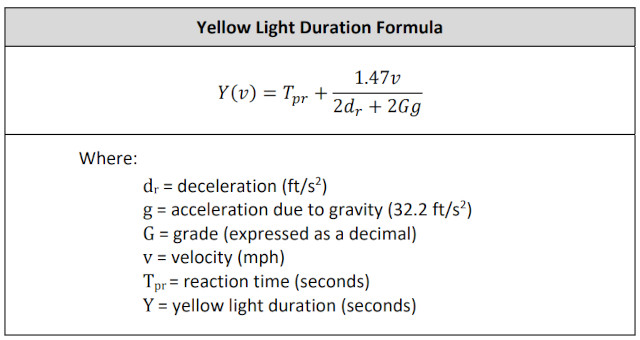 I need to know how long a yellow traffic light at an intersection should stay yellow for? I realize that the posted speed has to be taken into account and if there are advanced flashing amber lights.
I need to know how long a yellow traffic light at an intersection should stay yellow for? I realize that the posted speed has to be taken into account and if there are advanced flashing amber lights.
I was travelling down Dewdney Trunk Road and was going just under the posted 50 km/h limit. As I approached the intersection at 50 feet away the light went yellow.
I went to put the brake on and realized that I would not stop and would be in the intersection as a traffic hazard. I applied the gas pedal but the light went green.
An RCMP 300 feet on the other side coming south. I was going north. He thought he saw me run an amber light deliberately
Not the case.
I went back and timed the light with a stop watch and it changes from yellow to red in less than 2 seconds.
There is no possible way to stop without getting hit by another car.
How Long Should a Yellow Traffic Light Stay On?
Having browsed a number of sites and documents it would appear that a yellow light should remain on for a minimum of 3 seconds and a maximum of 6 seconds, depending on the design speed of the highway, the grade and the ability of a driver to view the light as they approach it.
In BC advance yellow warning signals are installed when the design speed is more than 70 km/h or visibility is limited.
FAQs posted on the Ministry of Transportation and Infrastructure's web site explain the following:
Are the Rules the Same Across Canada?
Generally yes. The Manual of Uniform Traffic Control Device (MUTCD) for Canada provides the basic guidelines for the design of traffic control devices, and provides recommended practice for installation of traffic control. Most provinces develop their own manuals with further detail and direction on traffic control devices that address geographical or historical traffic issues. Road authorities should comply with the basic principles outlined in the MUTCD.
In BC, the Motor Vehicle Act Regulation, Division 23, also defines the specification for various traffic control devices such as sign size, shape and colours, signal displays, and pavement marking colours and application. This statutory requirement ensures all public roads in BC have consistent application of traffic control devices.
No Free Access
Unfortunately, I have not been able to find a source of these documents on line to refer you to, but I did find the formula used if you would like to use it.
Yellow Traffic Light Interval Calculation

Learn More
Transport Association of Canada
Share This Article
I've done some personal research on the traffic lights in my area. I caught a flash of the red-light camera in my rear view mirror, so I wanted to check whether the yellow seemed short, or was actually short.
I filmed several intersections with my iPhone, making sure I caught the entire cycle of operation:
1 side green - 2 side red, 1 side yellow - 2 side red, 1 side red - 2 side red, 1 side red - 2 side green, 1 side red - 2 side yellow.
What I found with the video editing software (counting frames @ 30fps) is that most lights were close and always over 3 seconds yellow, and 3 seconds red-red (both streets showed red). Greens were longer for the main-street. The light with the red-light camera was 3.0 seconds on the dot, while the two lights preceding both-ways were 3.3-3.6 seconds for yellows
At the end I didn't get that ticket, but it was still fun filming :)
- Log in to post comments
- Log in to post comments

Yellow lights